Long Term Care Software Market Size
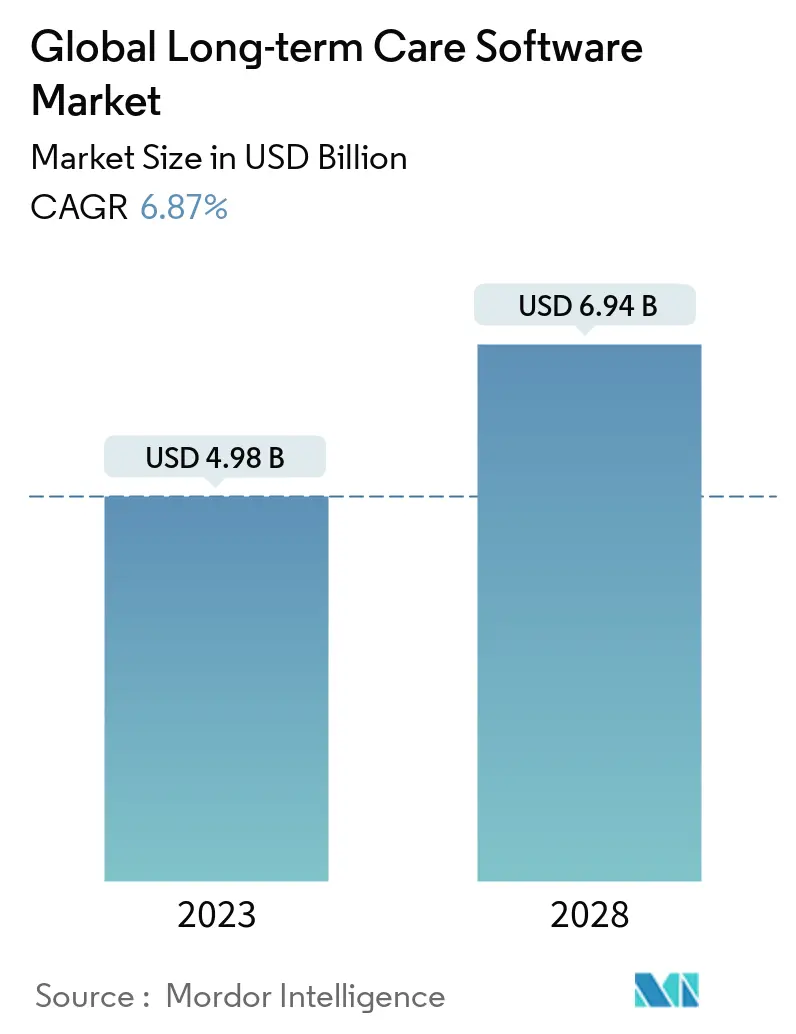
| Study Period | 2018 - 2028 |
| Market Size (2023) | USD 4.98 Billion |
| Market Size (2028) | USD 6.94 Billion |
| CAGR (2023 - 2028) | 6.87 % |
| Fastest Growing Market | Asia Pacific |
| Largest Market | North America |
Major Players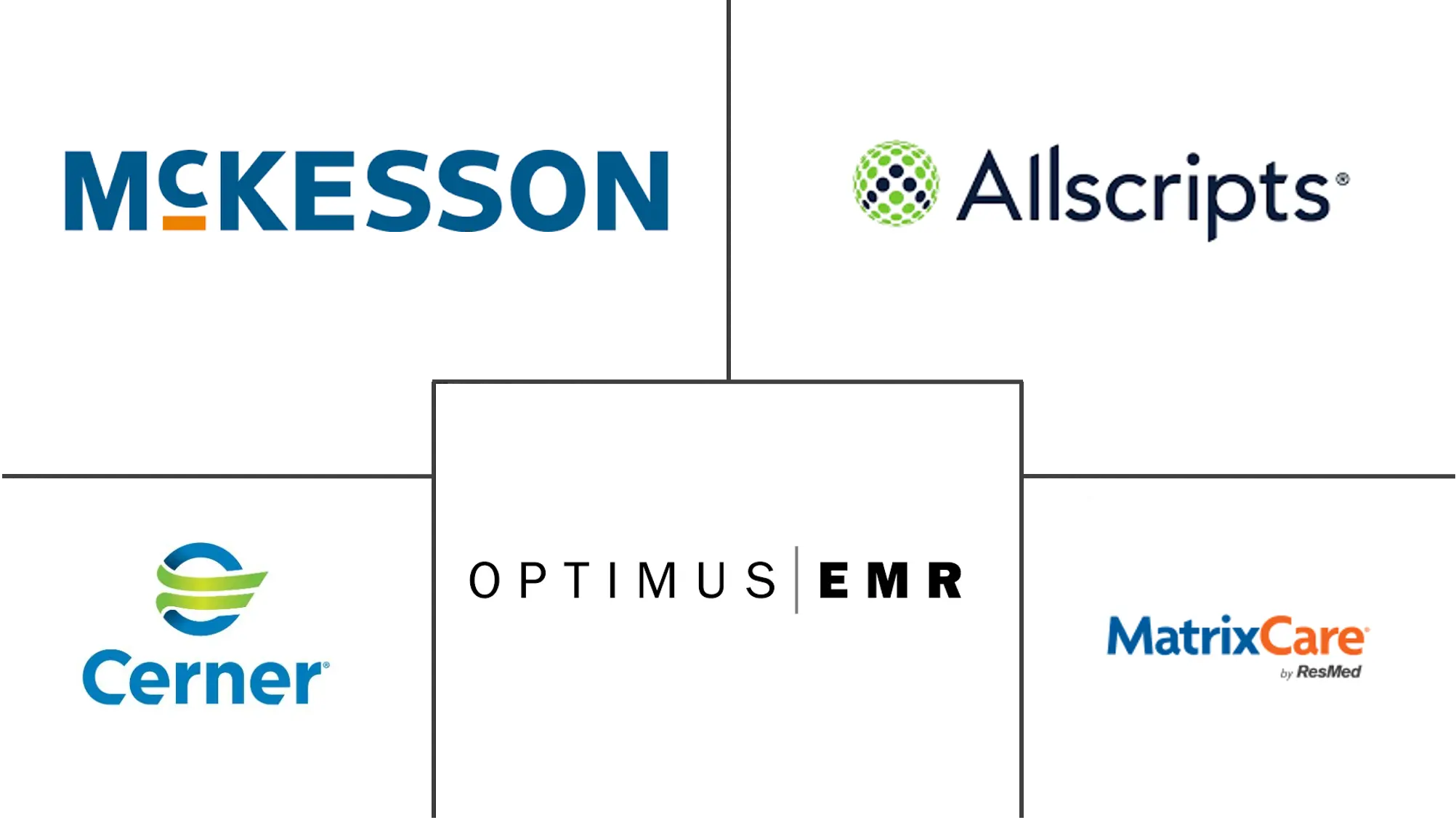
*Disclaimer: Major Players sorted in no particular order |
Need a report that reflects how COVID-19 has impacted this market and its growth?
Long Term Care Software Market Analysis
The Global Long-term Care Software Market size is expected to grow from USD 4.98 billion in 2023 to USD 6.94 billion by 2028, at a CAGR of 6.87% during the forecast period (2023-2028).
The COVID-19 pandemic affected the elderly population excessively, particularly those who are living at long-term care facilities (LTCF), with a significant impact on mortality and morbidity. As per the study article “COVID-19 excess mortality among long-term care residents in Ontario, Canada” published in January 2022, the mortality rate among long-term care residents was higher. Thus, strenuous action is required to alleviate the impact of COVID-19 by enhancing infection prevention and control (IPC) measures within LTCF with novel and advanced LTC software and solutions in order to track and manage the patients at LTCF affected with COVID-19. In November 2020, GHD revealed four new advanced solutions, namely SimpleTrack, Contact Connect wearables, Appointed, and Wastewater testing service, intended to increase the safety of residents in long-term care facilities through contact tracing, appointment bookings, and early notification of COVID-19 trends.
The major factors attributing to the growth of the long-term care software market are the healthcare reforms and government initiatives, the rise in the aging population, and the growing burden of chronic diseases. As per the data from World Health Organization, the number of people aged over 60 years and above is expected to reach 1.4 billion by the year 2030 and is projected to reach 2.4 billion by year 2050. As old people require more care, the market studied is believed to witness strong growth in future.
Among the patients requiring long-term care, some of the most frequent chronic medical conditions include hypertension, gastroesophageal reflux disease, diabetes, atrial fibrillation, anemia, arthritis, congestive heart failure, constipation, chronic obstructive pulmonary disease, cerebrovascular disease, dementia, osteoporosis, Parkinson's disease, peripheral vascular disease, renal failure, and thyroid disorders, amongst others. According to Alzheimer's Disease International, globally, there were around 50 million people with dementia in 2020. This number is expected to double every 20 years, reaching 82 million in 2030 and 152 million in 2050. Therefore, to control and monitor such a large section of the old age population, prone to any chronic disease, at any point of time, even if the disease is being occurred once, it is important to get them monitored at home care, nursing facility, or community centers, as well as assisted living centers. The importance of software and devices to connect to these centers, as well as patients, becomes a necessity, and thus, acts as one of the major drivers for the market studied.
Government policies and acts, such as the Health Information Technology for Economic and Clinical Health Act (HITECH), improve the healthcare quality, safety, management, and efficiency, including the electronic health records (EHRs) and a private and secure electronic health information exchange. Such type of information exchange is vital in proper disease management, in order to alert the clinicians in a timely manner.
Long Term Care Software Market Trends
This section covers the major market trends shaping the Long Term Care Software Market according to our research experts:
Electronic Health Records Projected to Have Notable Growth Rate Over the Forecast Period
EHRs are highly useful in the management of documentation, quality outcome, and health outcomes. The boost in productivity in the healthcare facility was observed over the period of two years. Increasing public and private financial incentives on the EHR adoption is driving the growth of the overall EHR market, while also impacting the long-term care EHR solutions, positively. The EHR can improve the quality of care in Long-term Care facilities through a reduction in medication-related errors, improved clinical documentation and decision making, and through the Health Information Exchange.
For instance, the federal government invested billions into training health information technology workers and establishing regional extension centers to deliver technical and other advice for the better transition towards an electronic system.
The adoption rate in developed markets is steadily increasing across long-term care, as well as home health agencies. This increase in the adoption rate is being noticed by the IT-based companies that are investing more in healthcare facilities, such as Allscripts.
Due to COVID-19 pandemic, the reliance of patientson online sources has increased which made it compulsive for healthcare providers to come up with easy to access health record platforms. Patient records are now largely generated and processed using electronic medical records (EMRs), which are managed by EMR software, and electronic health records (EHRs), which are maintained by EHR software.
Moreover, based on the current scenario of lockdown due to the outbreak of COVID-19 across some countries, the use of EHR systems is expected to help in monitoring and treating diseases in people who need regular consultation with doctors in monitoring their health condition. In January 2021, MEDITECH launched its COVID-19 Vaccination EHR solution, intending to streamline COVID-19 vaccine administration across health systems. These EHR registries can identify patients who are eligible for the vaccine, and it also shows which long-term facility residents have preexisting conditions.
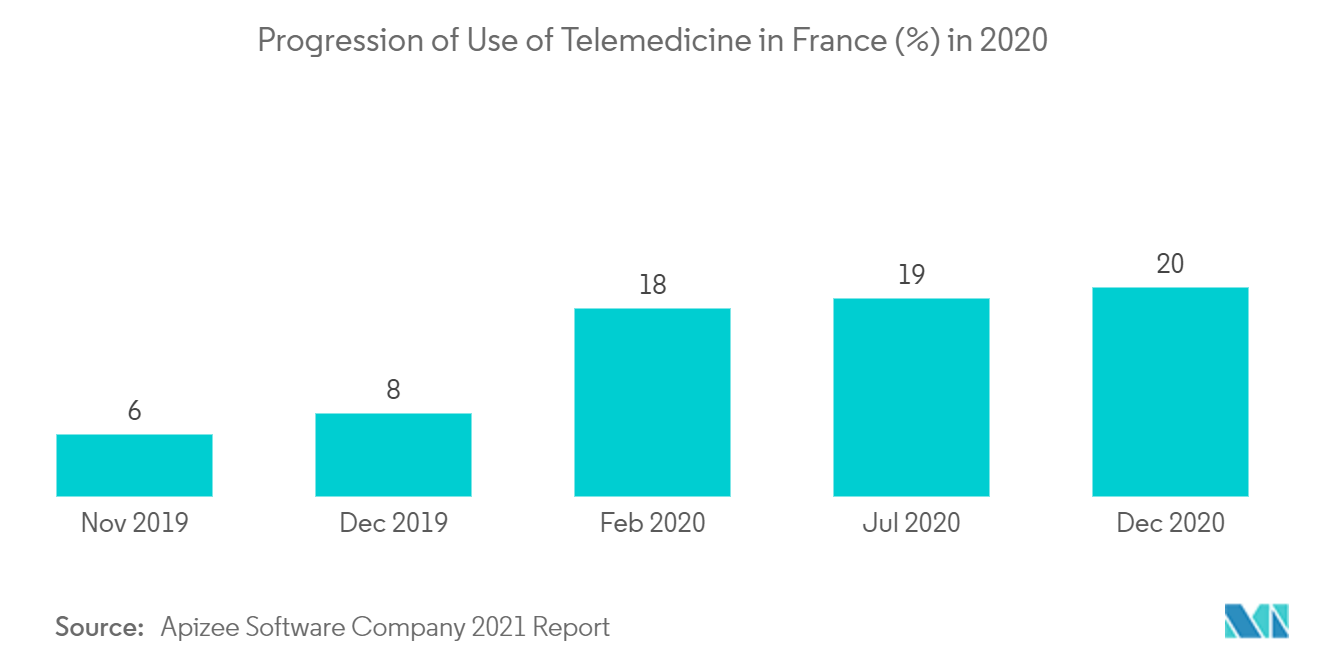
North America Dominates the Market, and is Believed to Witness the Same Trend Over the Forecast Period
North America is expected to dominate the overall market, throughout the forecast period. This is due to the increasing geriatric population and the favorable government policies, along with the presence of widespread insurance coverage. In North America, the United States holds the largest market share. This is mainly due to the high adoption rate of new technology software services across the country. For instance, the Drug Enforcement Administration (DEA) allowed practitioners to write prescriptions for controlled substances electronically. This allows for a reduction in prescription errors caused by illegible handwritten prescriptions.
Similarly, at the national level, the National Institute on Aging (NIA) helps in conducting and supporting research on aging and the health and well-being of older people. At the state level, some of the programs include the National Association of States United for Aging and Disabilities (NASUAD), Minnesota’s Long-Term Care Choices Navigator, Massachusetts Department of Elder Affairs, and the Georgia Department of Human Services (DHS) Division of Aging Services, among others.
Due to the sudden and severe COVID-19 outbreaks, timely epidemiological surveillance is essential for outbreak response, hence creating a huge demand for long-term software and solutions in the North American region. For instance, in June 2020, US-based Syft launched a new solution called incident surge recovery, and long-term preparedness solutions were developed to help hospitals optimize critical supply chain processes to improve care for COVID-19 patients, recover from COVID-19-related revenue losses, and prepare for future supply chain disruptions.
Therefore, owing to above-mentioned factors, the market studied is expected to witness significant share in North America region.
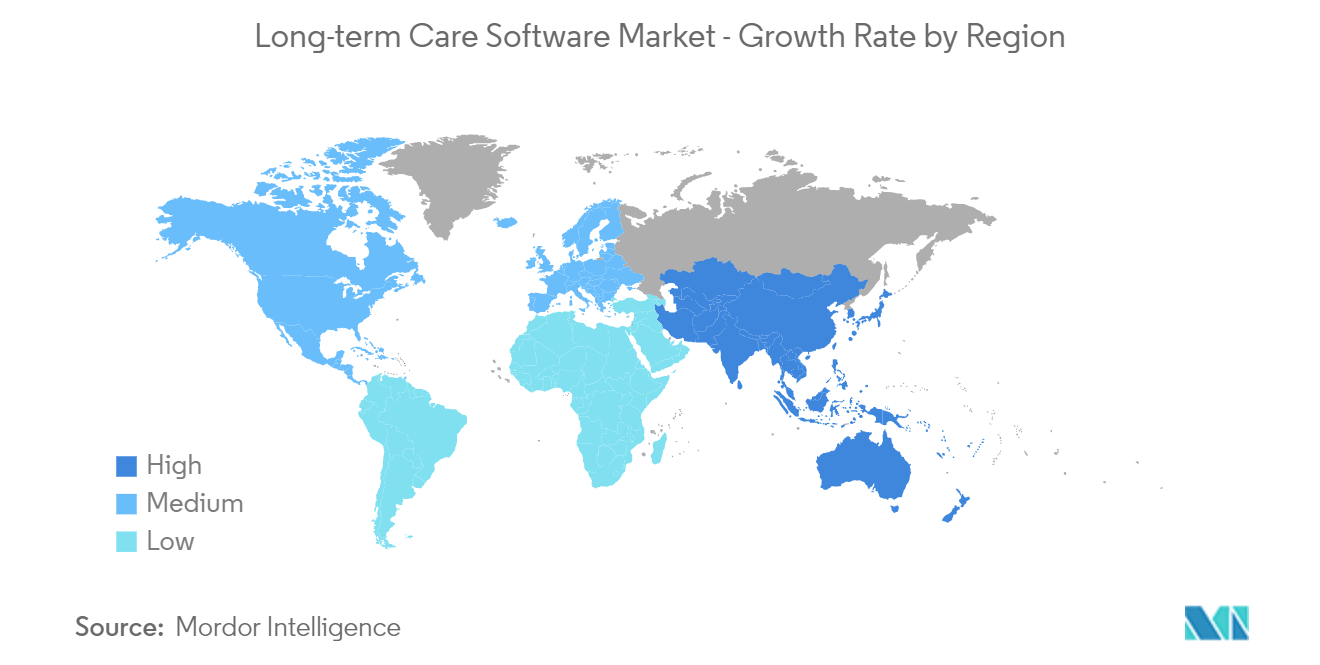
Long Term Care Software Industry Overview
The long-term care software market is moderately competitive and consists of several major players. In terms of shares, a few of the major players currently dominate the market. With the rising patient awareness levels and increasing geriatric population, a few other smaller players are expected to enter the market in the coming years. Some major players in the market include Allscripts Healthcare Solutions, Cerner Corporation, McKesson Corporation, Matrix Care, and Optimus EMR.
Long Term Care Software Market Leaders
Cerner Corporation
McKesson Corporation
Matrix Care
Optimus EMR
Allscripts Healthcare Solutions
*Disclaimer: Major Players sorted in no particular order
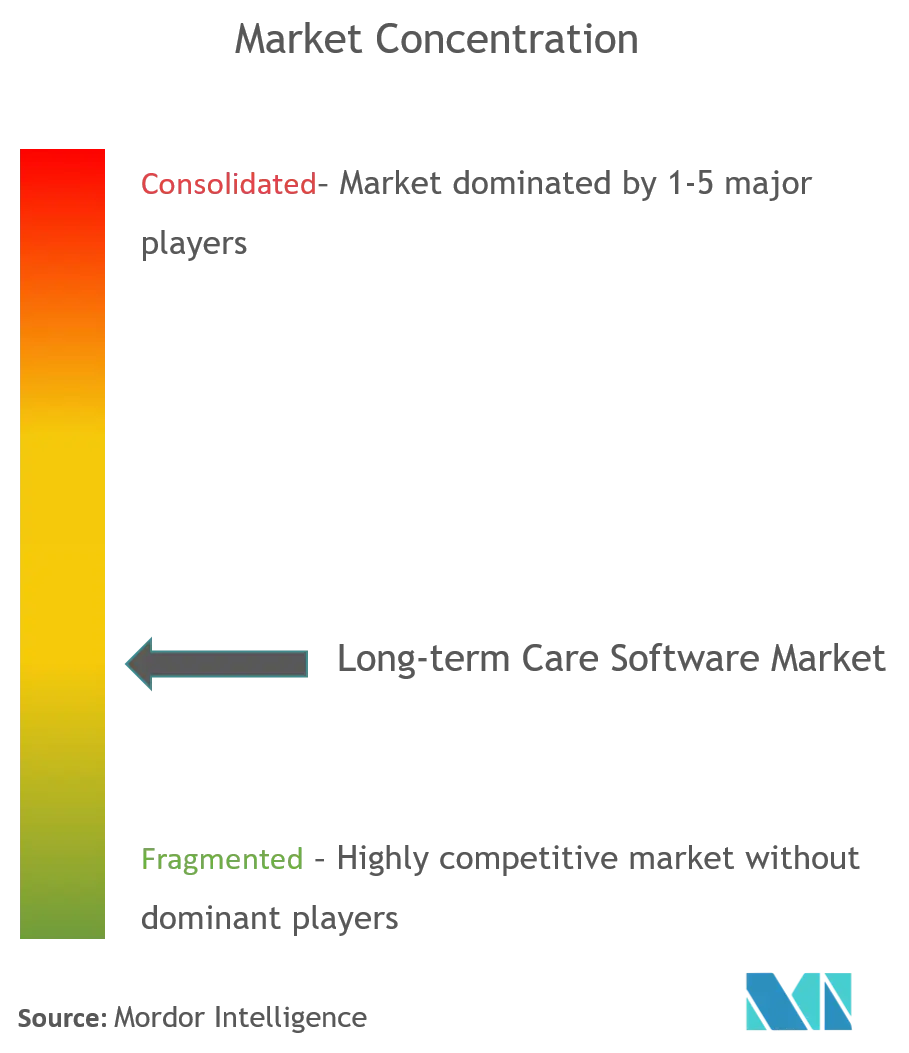
Long Term Care Software Market News
- In February 2022, Creative Solutions in Healthcare (CSNHC) launched a new software platform, Connected Care Center, to increase transparency in its 92 skilled nursing facilities.
- In February 2021, Capital Health launched a new EHR system across its two hospitals' acute care areas to better serve the community and its patients.
Long Term Care Software Market Report - Table of Contents
1. INTRODUCTION
1.1 Study Assumptions and Market Definition
1.2 Scope of the Study
2. RESEARCH METHODOLOGY
3. EXECUTIVE SUMMARY
4. MARKET DYNAMICS
4.1 Market Overview
4.2 Market Drivers
4.2.1 Rise in Aging Population
4.2.2 Healthcare Reforms and Government Initiatives
4.2.3 Growing Burden of Chronic Diseases
4.3 Market Restraints
4.3.1 Unwillingness of the Traditional Long-term Care Providers to Adopt Software
4.3.2 High Investment and Maintenance Costs
4.4 Porter's Five Forces Analysis
4.4.1 Threat of New Entrants
4.4.2 Bargaining Power of Buyers/Consumers
4.4.3 Bargaining Power of Suppliers
4.4.4 Threat of Substitute Products
4.4.5 Intensity of Competitive Rivalry
5. MARKET SEGMENTATION (Market Size by Value – USD million)
5.1 By Product
5.1.1 Electronic Health Records
5.1.2 E-prescribing
5.1.3 Clinical Decision Support Systems
5.1.4 Remote Patient Monitoring Systems
5.1.5 Real-Time Location Systems
5.1.6 Billing, Invoicing, and Scheduling Software
5.1.7 Other Products
5.2 By Deployment
5.2.1 Cloud-based
5.2.2 On-premise Based
5.3 By End User
5.3.1 Home Healthcare Agencies
5.3.2 Hospice Care Facilities
5.3.3 Nursing Homes and Assisted Living Facilities
5.4 Geography
5.4.1 North America
5.4.1.1 United States
5.4.1.2 Canada
5.4.1.3 Mexico
5.4.2 Europe
5.4.2.1 Germany
5.4.2.2 United Kingdom
5.4.2.3 France
5.4.2.4 Italy
5.4.2.5 Spain
5.4.2.6 Rest of Europe
5.4.3 Asia-Pacific
5.4.3.1 China
5.4.3.2 Japan
5.4.3.3 India
5.4.3.4 Australia
5.4.3.5 South Korea
5.4.3.6 Rest of Asia-Pacific
5.4.4 Middle-East and Africa
5.4.4.1 GCC
5.4.4.2 South Africa
5.4.4.3 Rest of Middle-East and Africa
5.4.5 South America
5.4.5.1 Brazil
5.4.5.2 Argentina
5.4.5.3 Rest of South America
6. COMPETITIVE LANDSCAPE
6.1 Company Profiles
6.1.1 Allscripts Healthcare Solutions
6.1.2 Cerner Corporation
6.1.3 Resmed (Matrix Care)
6.1.4 McKesson Corporation
6.1.5 CVS Health (Omnicare Inc.)
6.1.6 Netsmart Technologies Inc.
6.1.7 Yardi Systems Inc. (Optimus EMR)
6.1.8 PointClickCare
6.1.9 Lintech Software
6.1.10 Epic Systems Corporation
6.1.11 Medtelligent Inc.
6.1.12 Computer Programs and Systems Inc. (American HealthTech Inc.)
6.1.13 Eldermark
6.1.14 Sanvis Health LLC
6.1.15 ADL Data Systems Inc.
- *List Not Exhaustive
7. MARKET OPPORTUNITIES AND FUTURE TRENDS
Long Term Care Software Industry Segmentation
As per the scope of this report, long-term care software refers to software services that include electronic medical records, e-prescribing, medication management, patient monitoring, remote training, etc., which enhance the business operation’s needs, patient experience, and outcomes. The Long-term Care Software Market is segmented by Product (Electronic Health Records, E-prescribing, Clinical Decision Support Systems, Remote Patient Monitoring Systems, Real-time Location Systems, Billing, Invoicing, and Scheduling Software, and Other Products), Deployment (Cloud Bases and On-premise), End User (Home Healthcare Agencies, Hospice Care Facilities, and Nursing Homes and Assisted Living Facilities), and Geography (North America, Europe, Asia-Pacific, Middle-East and Africa, and South America). The report offers the value (in USD million) for the above segments. The market report also covers the estimated market sizes and trends for 17 different countries across major regions, globally.
| By Product | |
| Electronic Health Records | |
| E-prescribing | |
| Clinical Decision Support Systems | |
| Remote Patient Monitoring Systems | |
| Real-Time Location Systems | |
| Billing, Invoicing, and Scheduling Software | |
| Other Products |
| By Deployment | |
| Cloud-based | |
| On-premise Based |
| By End User | |
| Home Healthcare Agencies | |
| Hospice Care Facilities | |
| Nursing Homes and Assisted Living Facilities |
| Geography | ||||||||
| ||||||||
| ||||||||
| ||||||||
| ||||||||
|
Long Term Care Software Market Research FAQs
How big is the Global Long-term Care Software Market?
The Global Long-term Care Software Market size is expected to reach USD 4,978.12 million in 2023 and grow at a CAGR of 6.87% to reach USD 6,939.76 million by 2028.
What is the current Global Long-term Care Software Market size?
In 2023, the Global Long-term Care Software Market size is expected to reach USD 4,978.12 million.
Who are the key players in Global Long-term Care Software Market?
Cerner Corporation, McKesson Corporation, Matrix Care, Optimus EMR and Allscripts Healthcare Solutions are the major companies operating in the Global Long-term Care Software Market.
Which is the fastest growing region in Global Long-term Care Software Market?
Asia Pacific is estimated to grow at the highest CAGR over the forecast period (2023-2028).
Which region has the biggest share in Global Long-term Care Software Market?
In 2023, the North America accounts for the largest market share in the Global Long-term Care Software Market.
Global Long-term Care Software Industry Report
Statistics for the 2023 Global Long-term Care Software market share, size and revenue growth rate, created by Mordor Intelligence™ Industry Reports. Global Long-term Care Software analysis includes a market forecast outlook to 2028 and historical overview. Get a sample of this industry analysis as a free report PDF download.
